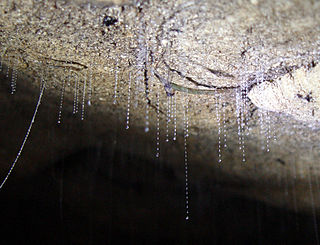 W
WArachnocampa is a genus of nine fungus gnat species which have a bioluminescent larval stage, akin to the larval stage of glowworm beetles. The species of Arachnocampa are endemic to Australia and New Zealand, dwelling in caves and grottos, or sheltered places in forests.
 W
WArachnocampa luminosa, commonly known as New Zealand glowworm or simply glowworm, is a species of fungus gnat endemic to New Zealand. The larval stage and the imago produce a blue-green bioluminescence. The species is known to dwell in caves and on sheltered banks in native bush where humidity is high. Its Māori name is titiwai, meaning "projected over water".
 W
WBelonogaster petiolata is a species of primitively eusocial wasp that dwells in southern Africa, in temperate or subhumid climate zones. This wasp species has a strong presence in South Africa and has also been seen in northern Johannesburg. Many colonies can be found in caves. The Sterkfontein Caves in South Africa, for example, contain large populations of B. petiolata.
 W
WHadenoecus is a genus of common cave cricket of the southeastern United States and typical of the tribe Hadenoecini.
 W
WNeotrogla is a genus of barklice noted for its reversed sex roles and organs, traits shared by all species of the genus.
 W
WOrfelia fultoni is one of the bioluminescent species of flies found in North America. It is distantly related to Arachnocampa, but their bioluminescent systems use distinct mechanisms. The larvae of the species live in stream banks among moss and rock cavities, as well as in wet sandstone caves. They build sticky webs, and using their two bioluminescent lanterns as an attractant, capture flying prey. They produce the bluest light of any studied bioluminescent insect. The species occurs in the Appalachian Mountains and Cumberland Plateau, primarily in the states of Alabama, North Carolina, Tennessee, and Virginia.
 W
WThe orthopteran family Rhaphidophoridae of the suborder Ensifera has a worldwide distribution. Common names for these insects include the cave wētā, cave crickets, camelback crickets, camel crickets, spider crickets and sand treaders. Those occurring in New Zealand, Australia, and Tasmania are typically referred to as jumping or cave wētā. Most are found in forest environments or within caves, animal burrows, cellars, under stones, or in wood or similar environments. All species are flightless and nocturnal, usually with long antennae and legs. More than 1100 species of Rhaphidophoridae are described.
 W
WTachycines asynamorus is a cave cricket and the type species of the genus Tachycines (Rhaphidophoridae). In English-speaking countries it is known as the greenhouse camel cricket or greenhouse stone cricket for its propensity for living in greenhouses. It was first described in 1902 by Russian entomologist Nicolai Adelung. Some authorities have placed this species in the genus Diestrammena, but it has now restored to its basonym.